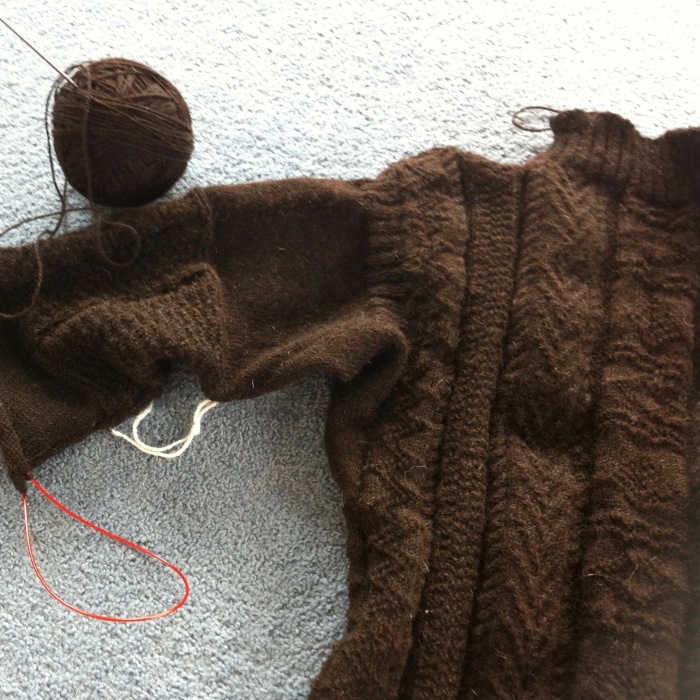
I have recently taken up knitting. It’s a natural extension of my interest in knots. There’s more to knitting than you might think. Here’s what I’ve found.
Knitting is mathematical
It’s not just arithmetic. There’s algebra. Here’s a problem for a sleeve. If I decrease x stitches every y rows until the fabric is 19 inches long, what values of x and y will give me a cuff of width 7 inches, when I have 8 stitches and 10 rows to the inch? Of course one can get ready-made answers. That’s what knitting patterns are for. Or one can do the maths.
There’s also non-Euclidean geometry, since knitted fabric is not flat. Sleeves must be eased into shoulders. Shoulder straps going crossways must be matched to knitting going lengthways. A hood has complex curves, impossible to envisage without the fabric in front of me.
But having tested my intellect. Knitting also tries my emotions.
Knitting confronts me with my fallibility

I cabled left when I should have cabled right
In many activities, you can blame other people, the weather, the tools. But in knitting, when you discover a mistake, you have only yourself to blame. The mistake is usually very obvious when you see it. You see that several rows back you purled when you should have knitted. You failed to decrease and so now the thing will be out-of-shape. You inadvertently created a stitch, so now the number of stitches is odd when it should be even. You cabled left, when you should have cabled right. You can see this mistake in the knitting: there it is, written out in time, incontrovertible. You now have that most interesting of decisions. Do I:
(a) Admit failure, do the work of undoing it all and correcting the mistake or
(b) Pretend it didn’t happen, ignore it and carry on.
With (a) the cost can be hours of time, especially for patterned work on a gansey. It’s also an admission of failure, and acknowledgement of fallibility. But (b) is a lifetime of knowing about that error, knotted into the pattern.
This type of decision occurs in life very often. It is useful, in a way I can’t describe, to have to practice it in the safe environment of a bit of knitting.
You have to live with the decisions you’ve made
Unlike dressmaking, where you can cut and adjust and remake as you go along, knitting is a craft where you commit to a course of action and must follow it through. The rows of a knitting pattern are knotted together in such a way that once knitted, you cannot adjust them except by undoing the whole garment and starting again. Once you’ve decided to knit a complicated knot pattern you can’t give up half way through.
When you look at a knitted garment, you see a line of time. There is a single thread, going back and forth, through the hard parts and the easy parts, and through the parts done perfectly and the parts that were a bit uneven. A piece of knitting, unlike an embroidery or painting, cannot be adjusted and perfected later. It is how it is.
It’s an important discipline to accept this time-line and live with it, just as one must accept the past, and the events in one’s life.
In knitting, as in life, very often the mistakes are not so obvious in the grand overall scale of things as they appear at the time. One learns to keep things in proportion.
Small repeated actions actions have large consequences.
It’s simply amazing that the tiny stitches in knitting add up to an overall pattern.

You do what seem like insignificant actions, and there, looking back, is a complete pattern: something created.
Life is like that. What I do today matters.
I shall make it count.
Categories: Learning, training, and enhancing capability
 I am a technical person – so why do I have to do sales?
I am a technical person – so why do I have to do sales?  Feedback conversations: make it a snack not a sandwich
Feedback conversations: make it a snack not a sandwich  Learning from Participating
Learning from Participating  What we can learn from the exercise classes
What we can learn from the exercise classes
I have a third option for responding to mistakes:
c) Accept them as they are and graciously carry on, embracing them as a lovely—albeit unexpected—twist to the story. Often it turns out that no one but you will know that was a mistake, and sometimes it’s alright to have a permanent reminder that we are not machines!
(Which, I realise is really what you are saying anyway! Great post Jane, absolutely spot.)